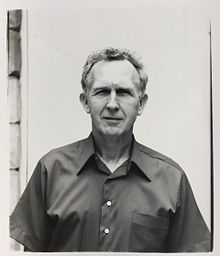Gene Hatfield
This article has multiple issues. Please help improve it or discuss these issues on the talk page. (Learn how and when to remove these messages)
|

Lester Gene Hatfield (November 23, 1925 - February 18, 2017),[1] known as Gene, was a lifetime artist and Distinguished Professor Emeritus of Art at the University of Central Arkansas in Conway, Arkansas. Hatfield was also a recipient of the Arkansas Arts Council Governor's Lifetime Achievement Award, an Arkansas Senate Citation, and a Purple Heart in addition to other various awards for his art and service.
Hatfield worked primarily in watercolor, oil, acrylic, pottery, stage sets, and various types of sculpture. He was perhaps best known locally[2] for his unique yard filled with sculptures[3] made from various found objects ranging from bicycles, to soda cans, to mops, to tin foil, and more. His famous eclectic outdoor art environment was a result of over forty years of working with materials that most people call “junk” or “trash” and turning it into works of art. Hatfield incorporated aspects of surrealism and folk art into his unique sculptures while more traditional late-nineteenth-century artists such as Paul Cézanne influenced his paintings. With a long tenure as an Art Teacher and contributor to UCA, Hatfield was an important part of Arkansas’ art culture.[1][2][4][5][6]
Early life, World War II, and education
Gene Hatfield was born on November 23, 1925 in Conway, Arkansas, to Lester and Gertrude Powers Hatfield. His father was a building contractor and his business was adversely impacted during the Great Depression. The financial setback was the impetus for the family to move from Conway to Mount Vernon, Arkansas. Hatfield's parents were originally from Mount Vernon and they lived there until 1937, when the Hatfield family moved back to Conway. Hatfield graduated from Conway High School in 1942 and enrolled at Arkansas State Teachers College in the fall of 1942. During his first stint in college, during World War II, Hatfield was one of the few male students on campus. After three semesters in college, Hatfield was drafted into the U.S.Army in January 1944. Hatfield completed his basic training at Fort Benning, Georgia and received additional training at Fort Bragg, North Carolina. In September 1944, he was sent to France, where he landed at Marseilles and waded ashore. His unit camped in a field outside Marseilles until they were picked up by Army trucks and taken to the war-front in Northern France. While in northern France, Hatfield's unit had to fight their way through the Vosges Mountains to the Rhine River. In April 1945, during combat, Hatfield suffered a severe shrapnel injury from an anti-tank grenade, which exploded in a tree right about his position. The shrapnel caused severe injuries to his face, and just missed his left eye. At a field hospital near Stuttgart, Germany, a surgeon removed all the shrapnel and saved his sight. He was then sent to a hospital in Tuscaloosa, Alabama where he recovered. For his wartime injury Hatfield received the Purple Heart.[5]
For his wartime service he also received the Bronze Star and a Medal of Meritorious Conduct. After he received an honorable discharge from the Army, Hatfield again enrolled in college and in the summer of 1947 he received a Bachelor of Science in Education from Arkansas State Teachers College. He then studied art in graduate school at the University of Northern Colorado in Greely, Colorado, where he earned a Master of Arts degree in art.[5]
Career, family life, and art
Hatfield's career as a professor of art, at what is now the University of Central Arkansas (UCA) began on September 1, 1948. His first year salary was $2,400 annually and Marie Schichtl was the head of the UCA Department of Art. Hatfield continued his education during the summer months, and he took advanced classes in Saint Ives, England, and in Paris, Fontainebleau, and Aix-en-Provence, France. Hatfield had a long career teaching in the UCA Department of Art and after 37 years he retired in 1985. In 1995, the UCA Board of Trustees named Gene Hatfield a Distinguished Professor Emeritus of Art.[5]
In 1957 Hatfield married Nicole Wable in Montreuil Sur-Mer France and the couple had three children, Hadrian, Marc and Mathilda. The Hatfield family had a very long connection to the University of Central Arkansas that began with Hatfield's older sister and continued through his children. Hadrian and Mathilda received degrees from the University of Central Arkansas and Marc also attended college at the University of Central Arkansas and graduated from the University of Arkansas.[5]
After Hatfield retired he maintained a keen interest in the University of Central Arkansas and the many events that took place on campus. He visited the campus frequently and discussed many topics with professors and students, but his passion was always art.
Life After Retirement and Death
Hatfield was most noted by having his yard around his home on Donaghey Avenue filled with sculptures, something that he took great pleasure in creating. In a conversation with this author, Hatfield commented that he knew the angels were directing him when he was painting a portrait or working on a sculpture. Hatfield remained active in art up until just a few months before he passed away. Hatfield died on February 18, 2017 at the age of 91.
References
- ^ a b "Hatfield remembered for his art and generosity". thecabin.net. Retrieved 29 June 2017.
- ^ a b "Conway man hosts yard of artistic peculiarities". Retrieved 2017-07-27.
- ^ "Yard Art by Gene Hatfield - Encyclopedia of Arkansas". www.encyclopediaofarkansas.net. Retrieved 2017-07-27.
- ^ "Gene Hatfield". Arkansas Online. 2008-12-14. Retrieved 2017-06-23.
- ^ a b c d e Bryant, William (26 July 2017). "The Gene Hatfield Collection - University of Central Arkansas Archives, M00-08". University of Central Arkansas Archives.
{{cite web}}: Cite has empty unknown parameter:|dead-url=(help) - ^ "Lester Gene Hatfield (1925–2017) - Encyclopedia of Arkansas". www.encyclopediaofarkansas.net. Retrieved 2017-06-23.
